Business and Management Report: An Analysis of Nike's Operations
VerifiedAdded on 2020/01/07
|10
|2805
|104
Report
AI Summary
This report offers a comprehensive analysis of Nike's business and management practices. It begins by examining the three organizational levels—operational, tactical, and strategic—and their respective responsibilities within the company, including decision-making processes. The report then delves into various leadership styles, such as autocratic, bureaucratic, facilitative, and Laissez-faire, and explores the specific leadership approach adopted by Nike. Furthermore, it assesses the effects of globalization on Nike, considering both the positive and negative impacts on the company's growth and expansion, including challenges related to adaptability and competition. Finally, the report evaluates Nike's corporate social responsibility (CSR) initiatives, discussing its responses to CSR concerns, the importance of transparency, and the impact of fair trade practices on the company's image and stakeholder relationships. The report highlights Nike's evolution in addressing CSR issues and its commitment to ethical business conduct.
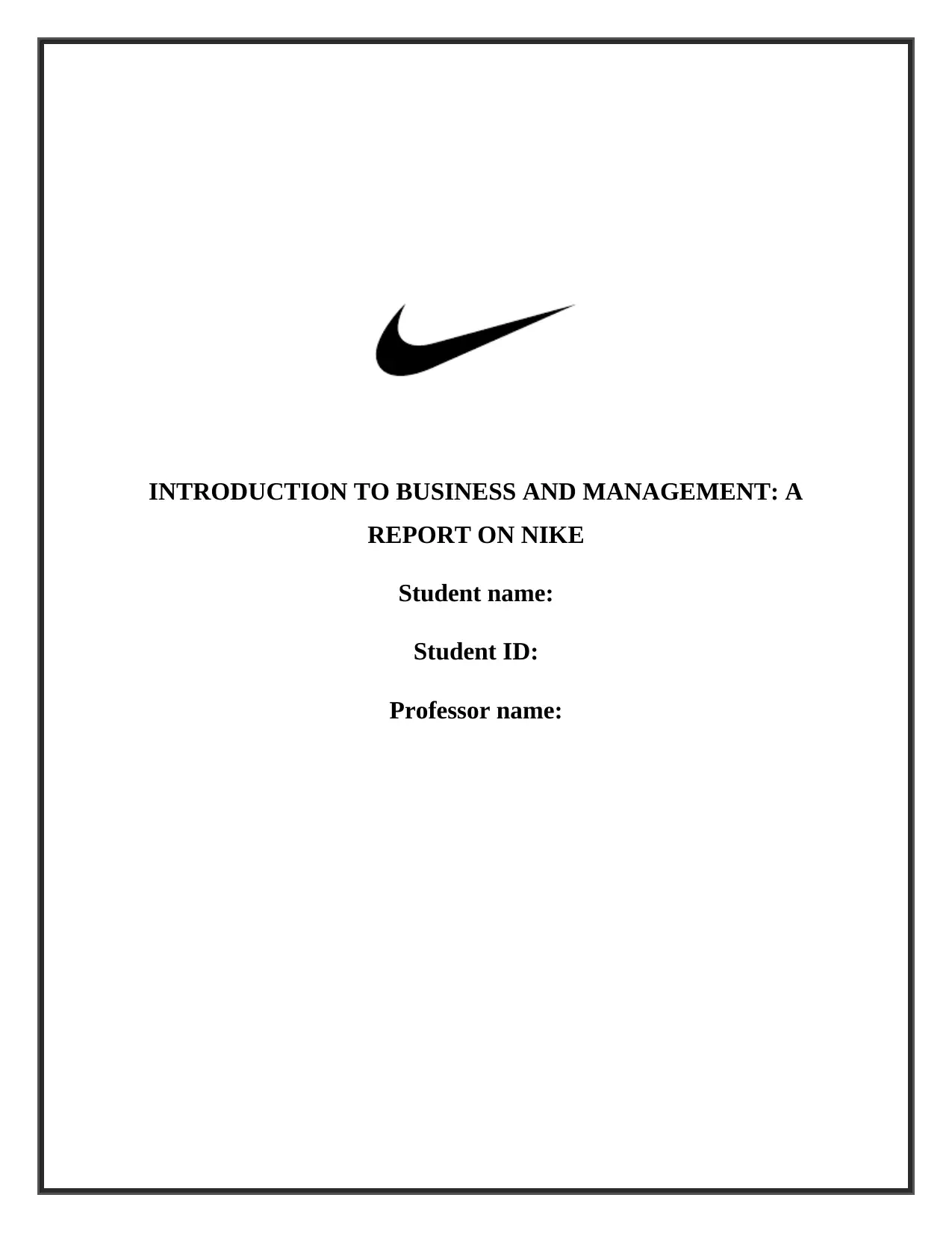
INTRODUCTION TO BUSINESS AND MANAGEMENT: A
REPORT ON NIKE
Student name:
Student ID:
Professor name:
REPORT ON NIKE
Student name:
Student ID:
Professor name:
Paraphrase This Document
Need a fresh take? Get an instant paraphrase of this document with our AI Paraphraser
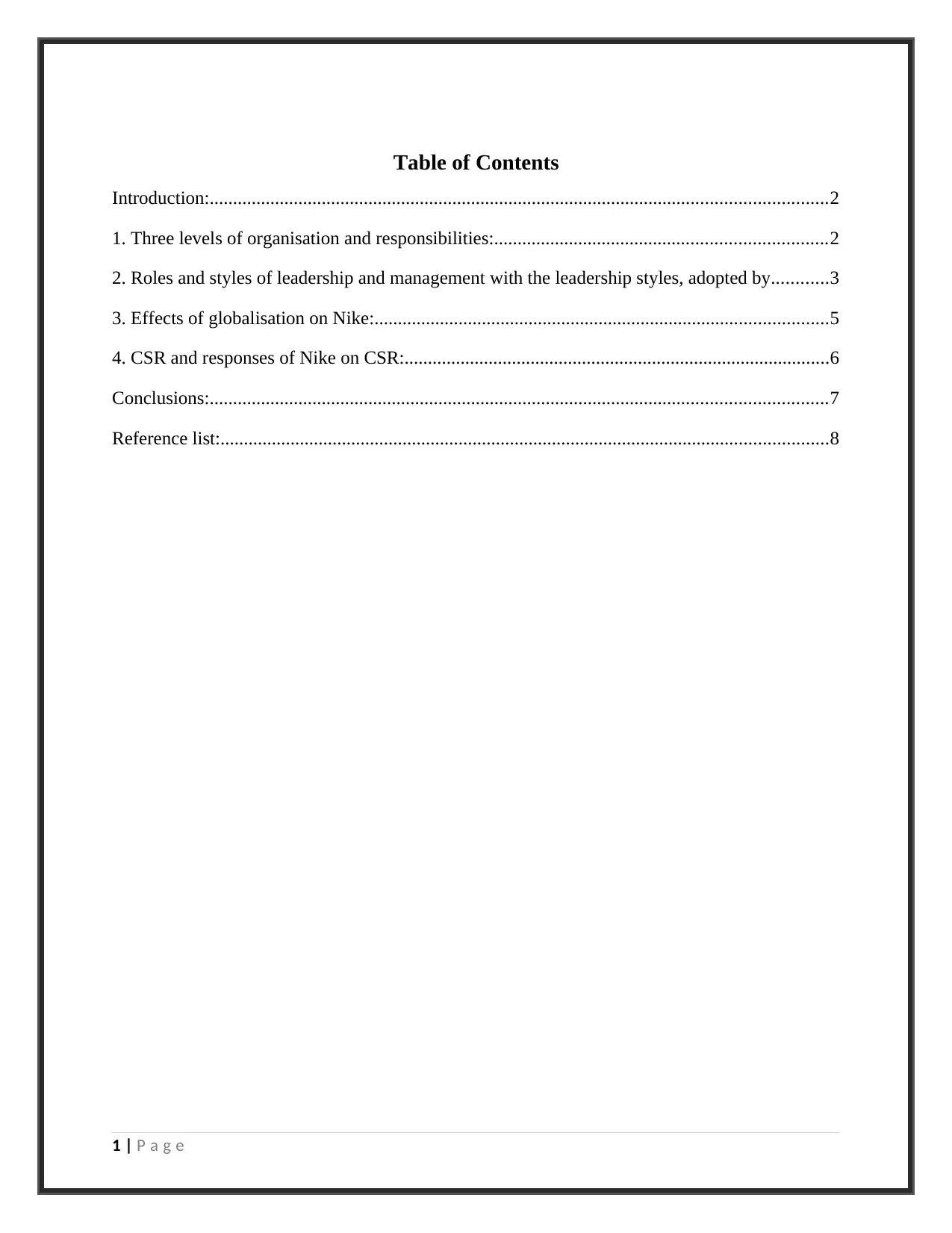
Table of Contents
Introduction:....................................................................................................................................2
1. Three levels of organisation and responsibilities:.......................................................................2
2. Roles and styles of leadership and management with the leadership styles, adopted by............3
3. Effects of globalisation on Nike:.................................................................................................5
4. CSR and responses of Nike on CSR:...........................................................................................6
Conclusions:....................................................................................................................................7
Reference list:..................................................................................................................................8
1 | P a g e
Introduction:....................................................................................................................................2
1. Three levels of organisation and responsibilities:.......................................................................2
2. Roles and styles of leadership and management with the leadership styles, adopted by............3
3. Effects of globalisation on Nike:.................................................................................................5
4. CSR and responses of Nike on CSR:...........................................................................................6
Conclusions:....................................................................................................................................7
Reference list:..................................................................................................................................8
1 | P a g e
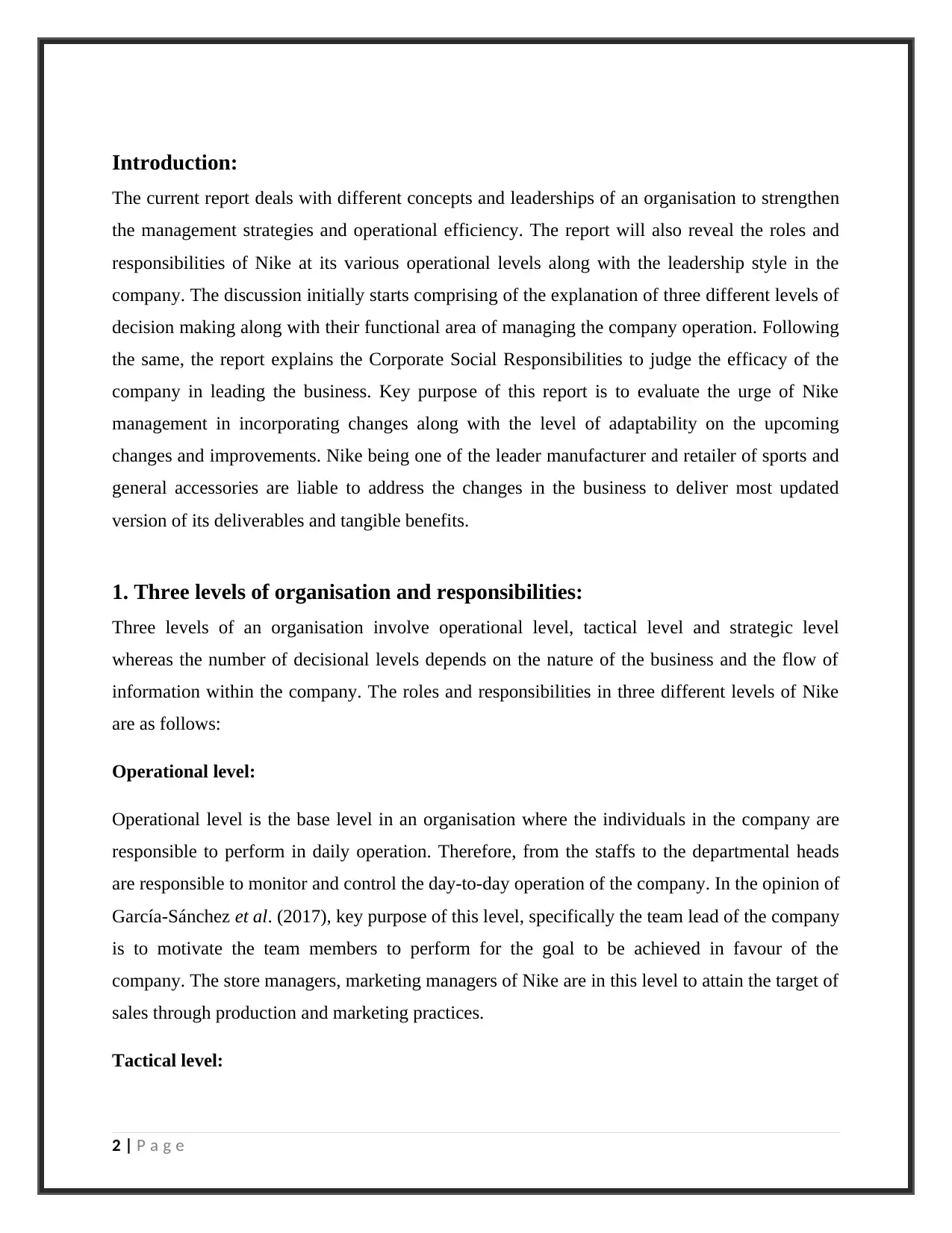
Introduction:
The current report deals with different concepts and leaderships of an organisation to strengthen
the management strategies and operational efficiency. The report will also reveal the roles and
responsibilities of Nike at its various operational levels along with the leadership style in the
company. The discussion initially starts comprising of the explanation of three different levels of
decision making along with their functional area of managing the company operation. Following
the same, the report explains the Corporate Social Responsibilities to judge the efficacy of the
company in leading the business. Key purpose of this report is to evaluate the urge of Nike
management in incorporating changes along with the level of adaptability on the upcoming
changes and improvements. Nike being one of the leader manufacturer and retailer of sports and
general accessories are liable to address the changes in the business to deliver most updated
version of its deliverables and tangible benefits.
1. Three levels of organisation and responsibilities:
Three levels of an organisation involve operational level, tactical level and strategic level
whereas the number of decisional levels depends on the nature of the business and the flow of
information within the company. The roles and responsibilities in three different levels of Nike
are as follows:
Operational level:
Operational level is the base level in an organisation where the individuals in the company are
responsible to perform in daily operation. Therefore, from the staffs to the departmental heads
are responsible to monitor and control the day-to-day operation of the company. In the opinion of
García-Sánchez et al. (2017), key purpose of this level, specifically the team lead of the company
is to motivate the team members to perform for the goal to be achieved in favour of the
company. The store managers, marketing managers of Nike are in this level to attain the target of
sales through production and marketing practices.
Tactical level:
2 | P a g e
The current report deals with different concepts and leaderships of an organisation to strengthen
the management strategies and operational efficiency. The report will also reveal the roles and
responsibilities of Nike at its various operational levels along with the leadership style in the
company. The discussion initially starts comprising of the explanation of three different levels of
decision making along with their functional area of managing the company operation. Following
the same, the report explains the Corporate Social Responsibilities to judge the efficacy of the
company in leading the business. Key purpose of this report is to evaluate the urge of Nike
management in incorporating changes along with the level of adaptability on the upcoming
changes and improvements. Nike being one of the leader manufacturer and retailer of sports and
general accessories are liable to address the changes in the business to deliver most updated
version of its deliverables and tangible benefits.
1. Three levels of organisation and responsibilities:
Three levels of an organisation involve operational level, tactical level and strategic level
whereas the number of decisional levels depends on the nature of the business and the flow of
information within the company. The roles and responsibilities in three different levels of Nike
are as follows:
Operational level:
Operational level is the base level in an organisation where the individuals in the company are
responsible to perform in daily operation. Therefore, from the staffs to the departmental heads
are responsible to monitor and control the day-to-day operation of the company. In the opinion of
García-Sánchez et al. (2017), key purpose of this level, specifically the team lead of the company
is to motivate the team members to perform for the goal to be achieved in favour of the
company. The store managers, marketing managers of Nike are in this level to attain the target of
sales through production and marketing practices.
Tactical level:
2 | P a g e
⊘ This is a preview!⊘
Do you want full access?
Subscribe today to unlock all pages.

Trusted by 1+ million students worldwide
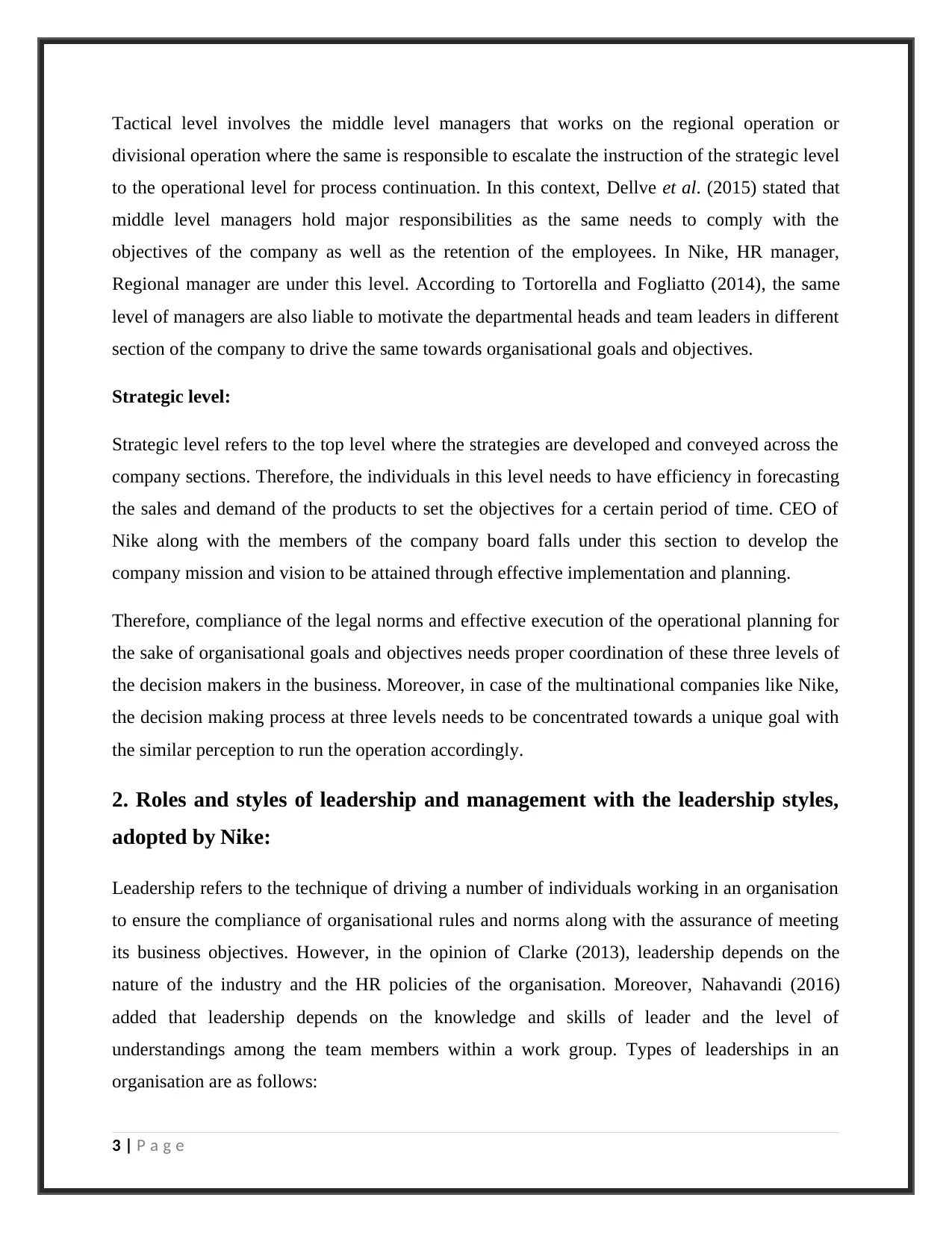
Tactical level involves the middle level managers that works on the regional operation or
divisional operation where the same is responsible to escalate the instruction of the strategic level
to the operational level for process continuation. In this context, Dellve et al. (2015) stated that
middle level managers hold major responsibilities as the same needs to comply with the
objectives of the company as well as the retention of the employees. In Nike, HR manager,
Regional manager are under this level. According to Tortorella and Fogliatto (2014), the same
level of managers are also liable to motivate the departmental heads and team leaders in different
section of the company to drive the same towards organisational goals and objectives.
Strategic level:
Strategic level refers to the top level where the strategies are developed and conveyed across the
company sections. Therefore, the individuals in this level needs to have efficiency in forecasting
the sales and demand of the products to set the objectives for a certain period of time. CEO of
Nike along with the members of the company board falls under this section to develop the
company mission and vision to be attained through effective implementation and planning.
Therefore, compliance of the legal norms and effective execution of the operational planning for
the sake of organisational goals and objectives needs proper coordination of these three levels of
the decision makers in the business. Moreover, in case of the multinational companies like Nike,
the decision making process at three levels needs to be concentrated towards a unique goal with
the similar perception to run the operation accordingly.
2. Roles and styles of leadership and management with the leadership styles,
adopted by Nike:
Leadership refers to the technique of driving a number of individuals working in an organisation
to ensure the compliance of organisational rules and norms along with the assurance of meeting
its business objectives. However, in the opinion of Clarke (2013), leadership depends on the
nature of the industry and the HR policies of the organisation. Moreover, Nahavandi (2016)
added that leadership depends on the knowledge and skills of leader and the level of
understandings among the team members within a work group. Types of leaderships in an
organisation are as follows:
3 | P a g e
divisional operation where the same is responsible to escalate the instruction of the strategic level
to the operational level for process continuation. In this context, Dellve et al. (2015) stated that
middle level managers hold major responsibilities as the same needs to comply with the
objectives of the company as well as the retention of the employees. In Nike, HR manager,
Regional manager are under this level. According to Tortorella and Fogliatto (2014), the same
level of managers are also liable to motivate the departmental heads and team leaders in different
section of the company to drive the same towards organisational goals and objectives.
Strategic level:
Strategic level refers to the top level where the strategies are developed and conveyed across the
company sections. Therefore, the individuals in this level needs to have efficiency in forecasting
the sales and demand of the products to set the objectives for a certain period of time. CEO of
Nike along with the members of the company board falls under this section to develop the
company mission and vision to be attained through effective implementation and planning.
Therefore, compliance of the legal norms and effective execution of the operational planning for
the sake of organisational goals and objectives needs proper coordination of these three levels of
the decision makers in the business. Moreover, in case of the multinational companies like Nike,
the decision making process at three levels needs to be concentrated towards a unique goal with
the similar perception to run the operation accordingly.
2. Roles and styles of leadership and management with the leadership styles,
adopted by Nike:
Leadership refers to the technique of driving a number of individuals working in an organisation
to ensure the compliance of organisational rules and norms along with the assurance of meeting
its business objectives. However, in the opinion of Clarke (2013), leadership depends on the
nature of the industry and the HR policies of the organisation. Moreover, Nahavandi (2016)
added that leadership depends on the knowledge and skills of leader and the level of
understandings among the team members within a work group. Types of leaderships in an
organisation are as follows:
3 | P a g e
Paraphrase This Document
Need a fresh take? Get an instant paraphrase of this document with our AI Paraphraser
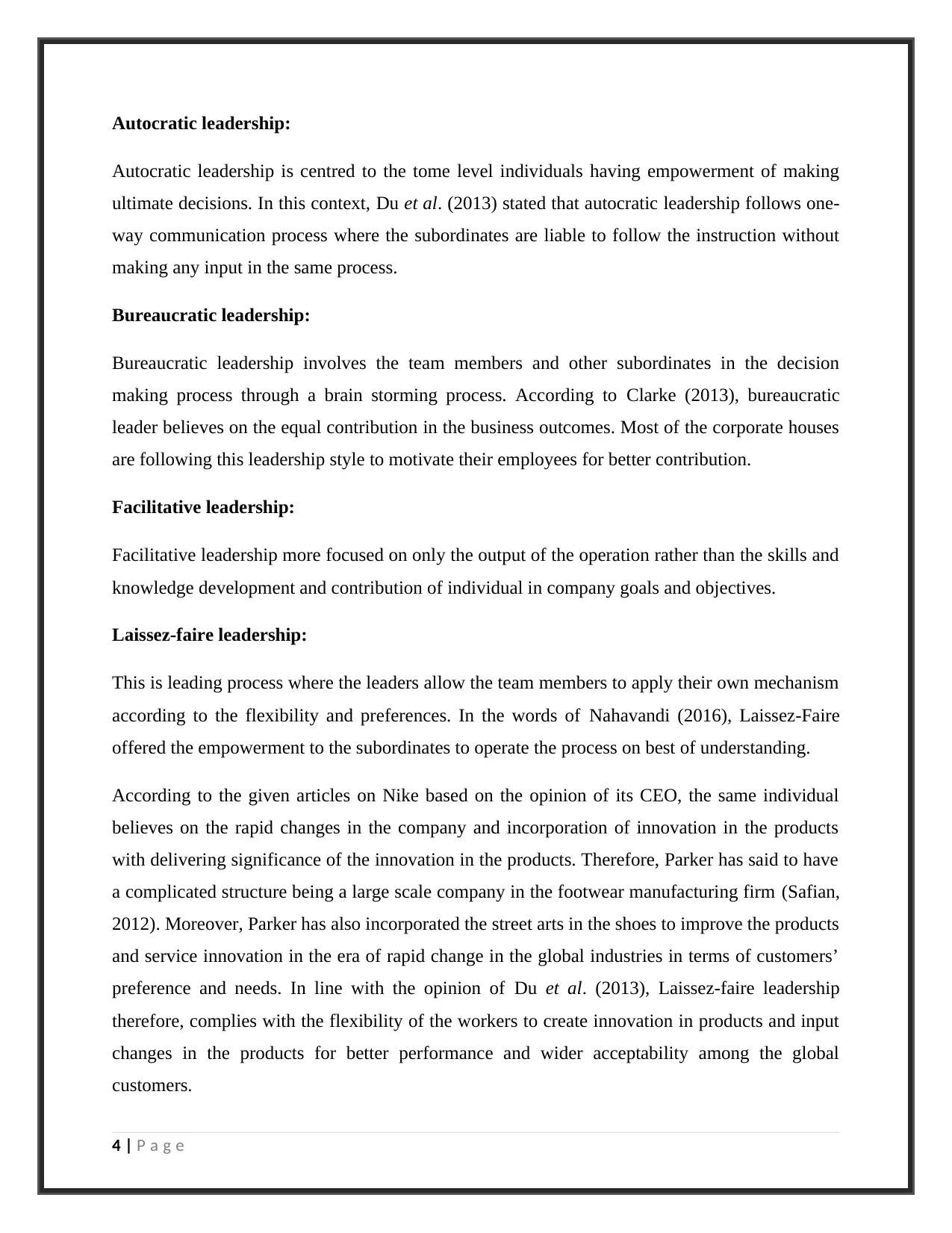
Autocratic leadership:
Autocratic leadership is centred to the tome level individuals having empowerment of making
ultimate decisions. In this context, Du et al. (2013) stated that autocratic leadership follows one-
way communication process where the subordinates are liable to follow the instruction without
making any input in the same process.
Bureaucratic leadership:
Bureaucratic leadership involves the team members and other subordinates in the decision
making process through a brain storming process. According to Clarke (2013), bureaucratic
leader believes on the equal contribution in the business outcomes. Most of the corporate houses
are following this leadership style to motivate their employees for better contribution.
Facilitative leadership:
Facilitative leadership more focused on only the output of the operation rather than the skills and
knowledge development and contribution of individual in company goals and objectives.
Laissez-faire leadership:
This is leading process where the leaders allow the team members to apply their own mechanism
according to the flexibility and preferences. In the words of Nahavandi (2016), Laissez-Faire
offered the empowerment to the subordinates to operate the process on best of understanding.
According to the given articles on Nike based on the opinion of its CEO, the same individual
believes on the rapid changes in the company and incorporation of innovation in the products
with delivering significance of the innovation in the products. Therefore, Parker has said to have
a complicated structure being a large scale company in the footwear manufacturing firm (Safian,
2012). Moreover, Parker has also incorporated the street arts in the shoes to improve the products
and service innovation in the era of rapid change in the global industries in terms of customers’
preference and needs. In line with the opinion of Du et al. (2013), Laissez-faire leadership
therefore, complies with the flexibility of the workers to create innovation in products and input
changes in the products for better performance and wider acceptability among the global
customers.
4 | P a g e
Autocratic leadership is centred to the tome level individuals having empowerment of making
ultimate decisions. In this context, Du et al. (2013) stated that autocratic leadership follows one-
way communication process where the subordinates are liable to follow the instruction without
making any input in the same process.
Bureaucratic leadership:
Bureaucratic leadership involves the team members and other subordinates in the decision
making process through a brain storming process. According to Clarke (2013), bureaucratic
leader believes on the equal contribution in the business outcomes. Most of the corporate houses
are following this leadership style to motivate their employees for better contribution.
Facilitative leadership:
Facilitative leadership more focused on only the output of the operation rather than the skills and
knowledge development and contribution of individual in company goals and objectives.
Laissez-faire leadership:
This is leading process where the leaders allow the team members to apply their own mechanism
according to the flexibility and preferences. In the words of Nahavandi (2016), Laissez-Faire
offered the empowerment to the subordinates to operate the process on best of understanding.
According to the given articles on Nike based on the opinion of its CEO, the same individual
believes on the rapid changes in the company and incorporation of innovation in the products
with delivering significance of the innovation in the products. Therefore, Parker has said to have
a complicated structure being a large scale company in the footwear manufacturing firm (Safian,
2012). Moreover, Parker has also incorporated the street arts in the shoes to improve the products
and service innovation in the era of rapid change in the global industries in terms of customers’
preference and needs. In line with the opinion of Du et al. (2013), Laissez-faire leadership
therefore, complies with the flexibility of the workers to create innovation in products and input
changes in the products for better performance and wider acceptability among the global
customers.
4 | P a g e
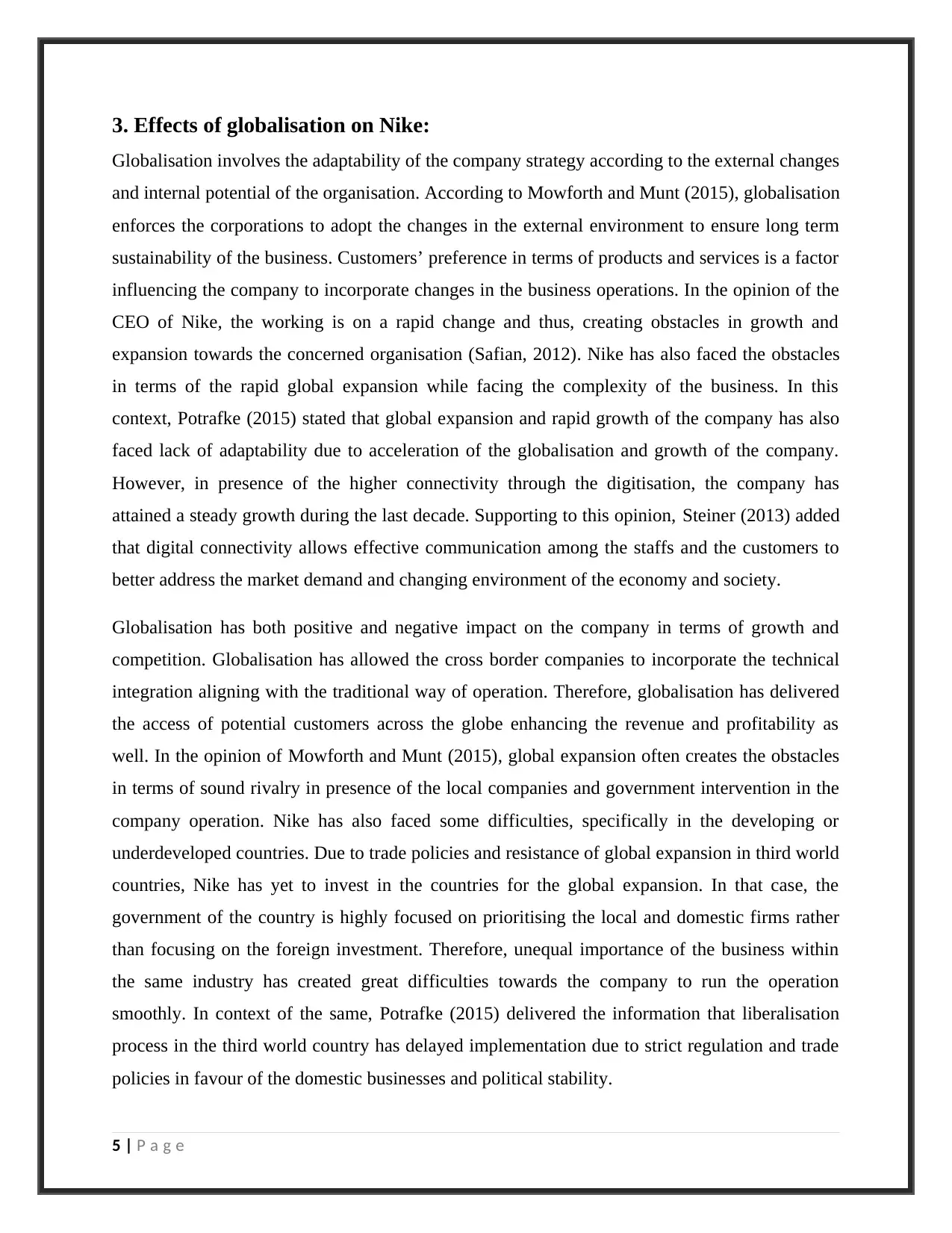
3. Effects of globalisation on Nike:
Globalisation involves the adaptability of the company strategy according to the external changes
and internal potential of the organisation. According to Mowforth and Munt (2015), globalisation
enforces the corporations to adopt the changes in the external environment to ensure long term
sustainability of the business. Customers’ preference in terms of products and services is a factor
influencing the company to incorporate changes in the business operations. In the opinion of the
CEO of Nike, the working is on a rapid change and thus, creating obstacles in growth and
expansion towards the concerned organisation (Safian, 2012). Nike has also faced the obstacles
in terms of the rapid global expansion while facing the complexity of the business. In this
context, Potrafke (2015) stated that global expansion and rapid growth of the company has also
faced lack of adaptability due to acceleration of the globalisation and growth of the company.
However, in presence of the higher connectivity through the digitisation, the company has
attained a steady growth during the last decade. Supporting to this opinion, Steiner (2013) added
that digital connectivity allows effective communication among the staffs and the customers to
better address the market demand and changing environment of the economy and society.
Globalisation has both positive and negative impact on the company in terms of growth and
competition. Globalisation has allowed the cross border companies to incorporate the technical
integration aligning with the traditional way of operation. Therefore, globalisation has delivered
the access of potential customers across the globe enhancing the revenue and profitability as
well. In the opinion of Mowforth and Munt (2015), global expansion often creates the obstacles
in terms of sound rivalry in presence of the local companies and government intervention in the
company operation. Nike has also faced some difficulties, specifically in the developing or
underdeveloped countries. Due to trade policies and resistance of global expansion in third world
countries, Nike has yet to invest in the countries for the global expansion. In that case, the
government of the country is highly focused on prioritising the local and domestic firms rather
than focusing on the foreign investment. Therefore, unequal importance of the business within
the same industry has created great difficulties towards the company to run the operation
smoothly. In context of the same, Potrafke (2015) delivered the information that liberalisation
process in the third world country has delayed implementation due to strict regulation and trade
policies in favour of the domestic businesses and political stability.
5 | P a g e
Globalisation involves the adaptability of the company strategy according to the external changes
and internal potential of the organisation. According to Mowforth and Munt (2015), globalisation
enforces the corporations to adopt the changes in the external environment to ensure long term
sustainability of the business. Customers’ preference in terms of products and services is a factor
influencing the company to incorporate changes in the business operations. In the opinion of the
CEO of Nike, the working is on a rapid change and thus, creating obstacles in growth and
expansion towards the concerned organisation (Safian, 2012). Nike has also faced the obstacles
in terms of the rapid global expansion while facing the complexity of the business. In this
context, Potrafke (2015) stated that global expansion and rapid growth of the company has also
faced lack of adaptability due to acceleration of the globalisation and growth of the company.
However, in presence of the higher connectivity through the digitisation, the company has
attained a steady growth during the last decade. Supporting to this opinion, Steiner (2013) added
that digital connectivity allows effective communication among the staffs and the customers to
better address the market demand and changing environment of the economy and society.
Globalisation has both positive and negative impact on the company in terms of growth and
competition. Globalisation has allowed the cross border companies to incorporate the technical
integration aligning with the traditional way of operation. Therefore, globalisation has delivered
the access of potential customers across the globe enhancing the revenue and profitability as
well. In the opinion of Mowforth and Munt (2015), global expansion often creates the obstacles
in terms of sound rivalry in presence of the local companies and government intervention in the
company operation. Nike has also faced some difficulties, specifically in the developing or
underdeveloped countries. Due to trade policies and resistance of global expansion in third world
countries, Nike has yet to invest in the countries for the global expansion. In that case, the
government of the country is highly focused on prioritising the local and domestic firms rather
than focusing on the foreign investment. Therefore, unequal importance of the business within
the same industry has created great difficulties towards the company to run the operation
smoothly. In context of the same, Potrafke (2015) delivered the information that liberalisation
process in the third world country has delayed implementation due to strict regulation and trade
policies in favour of the domestic businesses and political stability.
5 | P a g e
⊘ This is a preview!⊘
Do you want full access?
Subscribe today to unlock all pages.

Trusted by 1+ million students worldwide
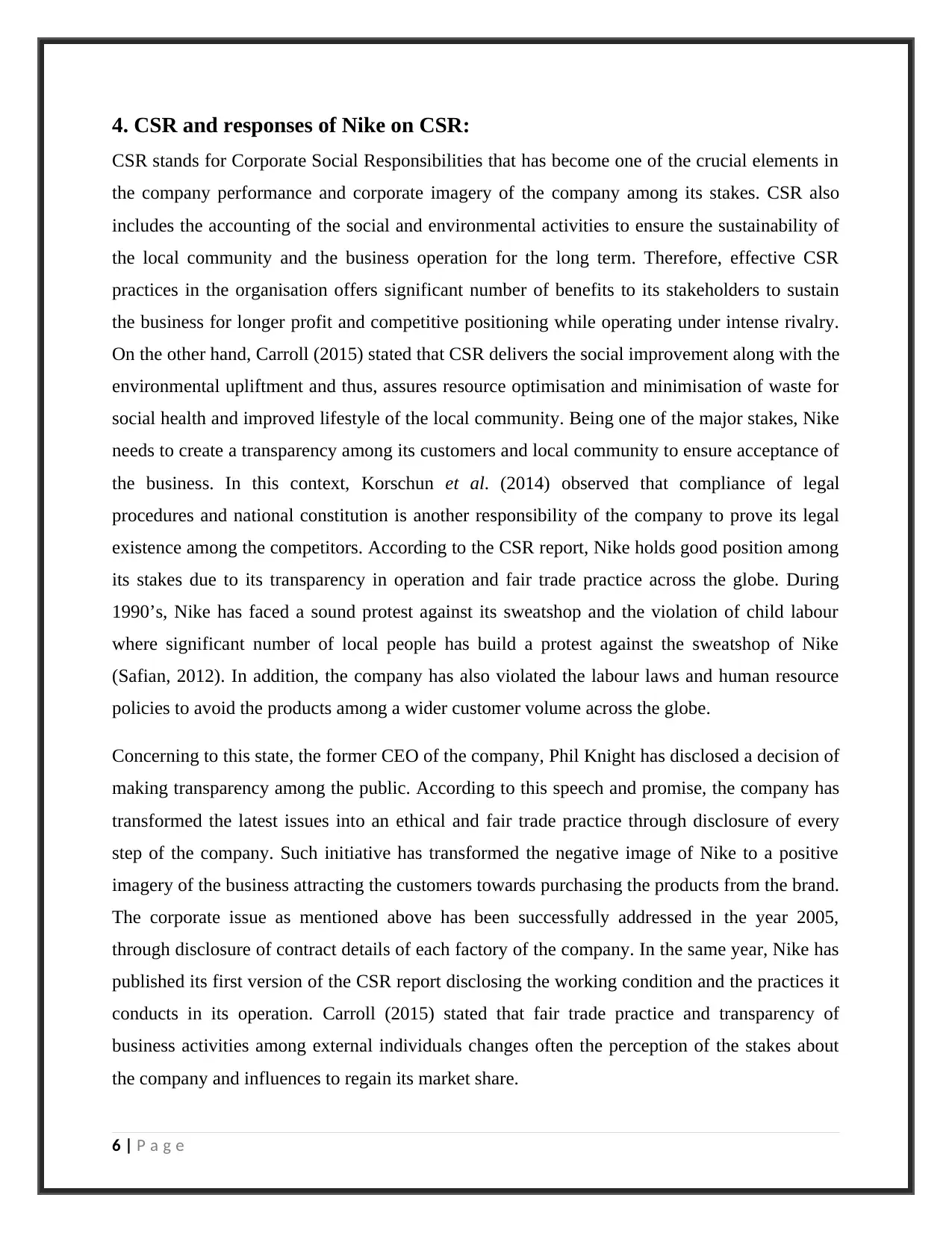
4. CSR and responses of Nike on CSR:
CSR stands for Corporate Social Responsibilities that has become one of the crucial elements in
the company performance and corporate imagery of the company among its stakes. CSR also
includes the accounting of the social and environmental activities to ensure the sustainability of
the local community and the business operation for the long term. Therefore, effective CSR
practices in the organisation offers significant number of benefits to its stakeholders to sustain
the business for longer profit and competitive positioning while operating under intense rivalry.
On the other hand, Carroll (2015) stated that CSR delivers the social improvement along with the
environmental upliftment and thus, assures resource optimisation and minimisation of waste for
social health and improved lifestyle of the local community. Being one of the major stakes, Nike
needs to create a transparency among its customers and local community to ensure acceptance of
the business. In this context, Korschun et al. (2014) observed that compliance of legal
procedures and national constitution is another responsibility of the company to prove its legal
existence among the competitors. According to the CSR report, Nike holds good position among
its stakes due to its transparency in operation and fair trade practice across the globe. During
1990’s, Nike has faced a sound protest against its sweatshop and the violation of child labour
where significant number of local people has build a protest against the sweatshop of Nike
(Safian, 2012). In addition, the company has also violated the labour laws and human resource
policies to avoid the products among a wider customer volume across the globe.
Concerning to this state, the former CEO of the company, Phil Knight has disclosed a decision of
making transparency among the public. According to this speech and promise, the company has
transformed the latest issues into an ethical and fair trade practice through disclosure of every
step of the company. Such initiative has transformed the negative image of Nike to a positive
imagery of the business attracting the customers towards purchasing the products from the brand.
The corporate issue as mentioned above has been successfully addressed in the year 2005,
through disclosure of contract details of each factory of the company. In the same year, Nike has
published its first version of the CSR report disclosing the working condition and the practices it
conducts in its operation. Carroll (2015) stated that fair trade practice and transparency of
business activities among external individuals changes often the perception of the stakes about
the company and influences to regain its market share.
6 | P a g e
CSR stands for Corporate Social Responsibilities that has become one of the crucial elements in
the company performance and corporate imagery of the company among its stakes. CSR also
includes the accounting of the social and environmental activities to ensure the sustainability of
the local community and the business operation for the long term. Therefore, effective CSR
practices in the organisation offers significant number of benefits to its stakeholders to sustain
the business for longer profit and competitive positioning while operating under intense rivalry.
On the other hand, Carroll (2015) stated that CSR delivers the social improvement along with the
environmental upliftment and thus, assures resource optimisation and minimisation of waste for
social health and improved lifestyle of the local community. Being one of the major stakes, Nike
needs to create a transparency among its customers and local community to ensure acceptance of
the business. In this context, Korschun et al. (2014) observed that compliance of legal
procedures and national constitution is another responsibility of the company to prove its legal
existence among the competitors. According to the CSR report, Nike holds good position among
its stakes due to its transparency in operation and fair trade practice across the globe. During
1990’s, Nike has faced a sound protest against its sweatshop and the violation of child labour
where significant number of local people has build a protest against the sweatshop of Nike
(Safian, 2012). In addition, the company has also violated the labour laws and human resource
policies to avoid the products among a wider customer volume across the globe.
Concerning to this state, the former CEO of the company, Phil Knight has disclosed a decision of
making transparency among the public. According to this speech and promise, the company has
transformed the latest issues into an ethical and fair trade practice through disclosure of every
step of the company. Such initiative has transformed the negative image of Nike to a positive
imagery of the business attracting the customers towards purchasing the products from the brand.
The corporate issue as mentioned above has been successfully addressed in the year 2005,
through disclosure of contract details of each factory of the company. In the same year, Nike has
published its first version of the CSR report disclosing the working condition and the practices it
conducts in its operation. Carroll (2015) stated that fair trade practice and transparency of
business activities among external individuals changes often the perception of the stakes about
the company and influences to regain its market share.
6 | P a g e
Paraphrase This Document
Need a fresh take? Get an instant paraphrase of this document with our AI Paraphraser
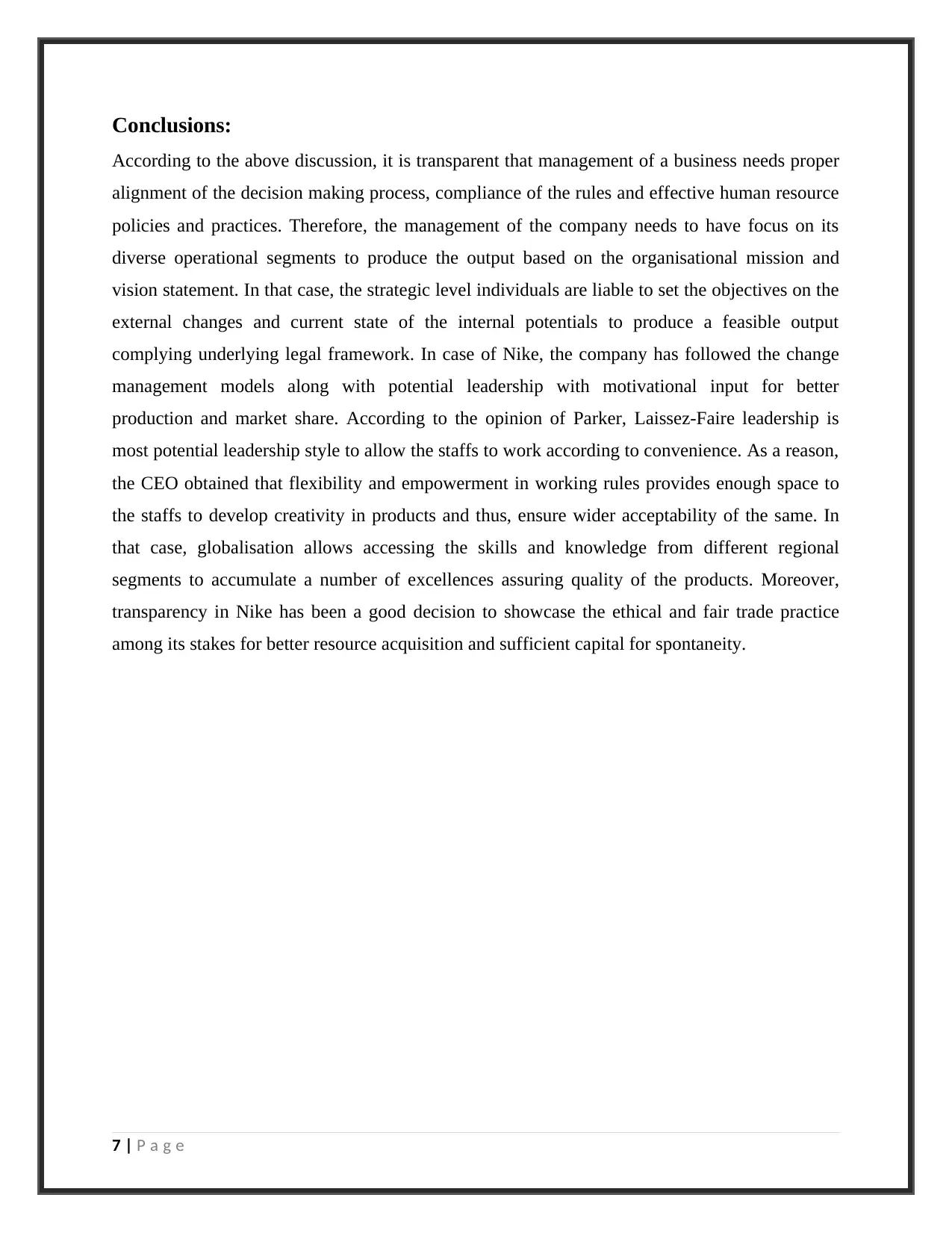
Conclusions:
According to the above discussion, it is transparent that management of a business needs proper
alignment of the decision making process, compliance of the rules and effective human resource
policies and practices. Therefore, the management of the company needs to have focus on its
diverse operational segments to produce the output based on the organisational mission and
vision statement. In that case, the strategic level individuals are liable to set the objectives on the
external changes and current state of the internal potentials to produce a feasible output
complying underlying legal framework. In case of Nike, the company has followed the change
management models along with potential leadership with motivational input for better
production and market share. According to the opinion of Parker, Laissez-Faire leadership is
most potential leadership style to allow the staffs to work according to convenience. As a reason,
the CEO obtained that flexibility and empowerment in working rules provides enough space to
the staffs to develop creativity in products and thus, ensure wider acceptability of the same. In
that case, globalisation allows accessing the skills and knowledge from different regional
segments to accumulate a number of excellences assuring quality of the products. Moreover,
transparency in Nike has been a good decision to showcase the ethical and fair trade practice
among its stakes for better resource acquisition and sufficient capital for spontaneity.
7 | P a g e
According to the above discussion, it is transparent that management of a business needs proper
alignment of the decision making process, compliance of the rules and effective human resource
policies and practices. Therefore, the management of the company needs to have focus on its
diverse operational segments to produce the output based on the organisational mission and
vision statement. In that case, the strategic level individuals are liable to set the objectives on the
external changes and current state of the internal potentials to produce a feasible output
complying underlying legal framework. In case of Nike, the company has followed the change
management models along with potential leadership with motivational input for better
production and market share. According to the opinion of Parker, Laissez-Faire leadership is
most potential leadership style to allow the staffs to work according to convenience. As a reason,
the CEO obtained that flexibility and empowerment in working rules provides enough space to
the staffs to develop creativity in products and thus, ensure wider acceptability of the same. In
that case, globalisation allows accessing the skills and knowledge from different regional
segments to accumulate a number of excellences assuring quality of the products. Moreover,
transparency in Nike has been a good decision to showcase the ethical and fair trade practice
among its stakes for better resource acquisition and sufficient capital for spontaneity.
7 | P a g e
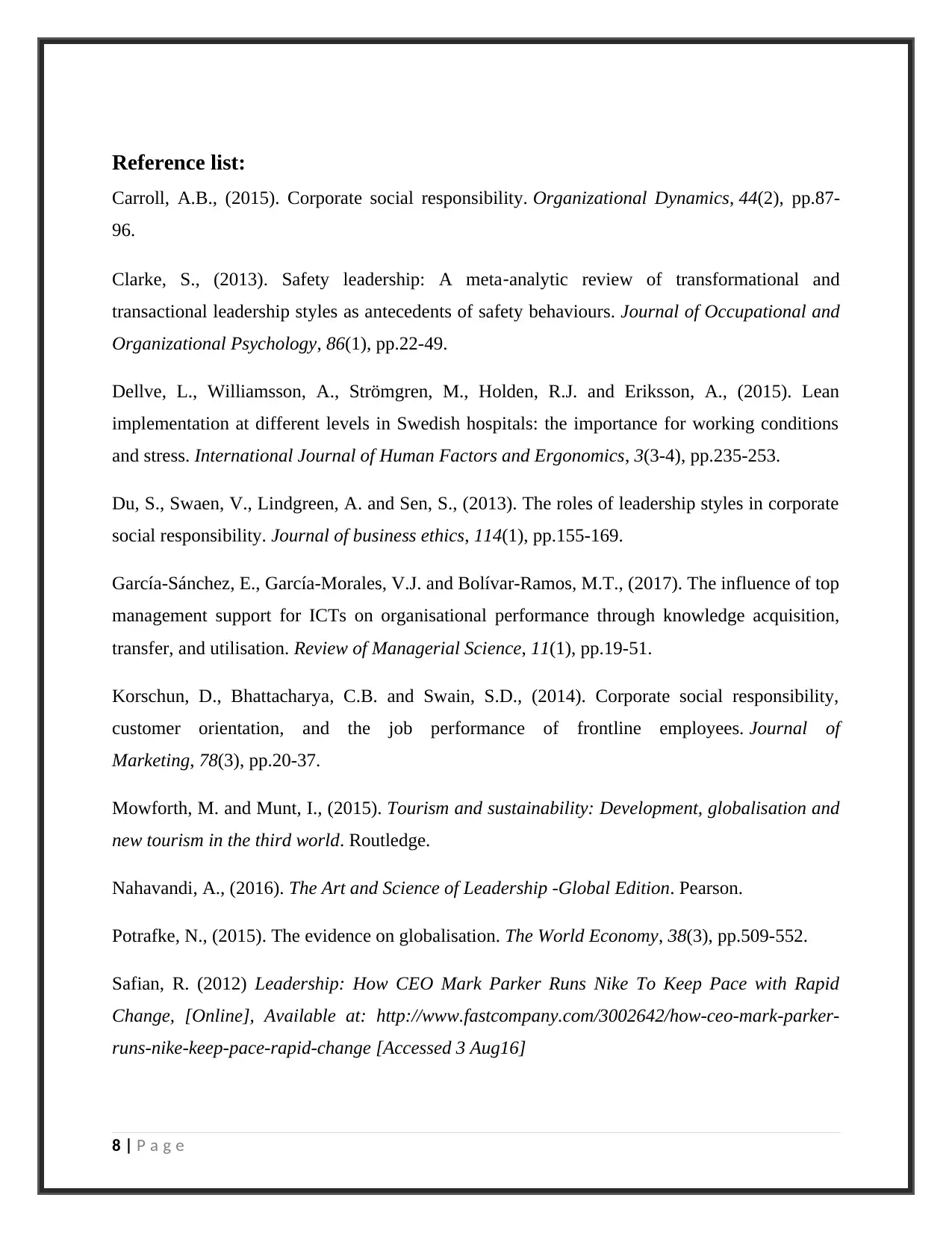
Reference list:
Carroll, A.B., (2015). Corporate social responsibility. Organizational Dynamics, 44(2), pp.87-
96.
Clarke, S., (2013). Safety leadership: A meta‐analytic review of transformational and
transactional leadership styles as antecedents of safety behaviours. Journal of Occupational and
Organizational Psychology, 86(1), pp.22-49.
Dellve, L., Williamsson, A., Strömgren, M., Holden, R.J. and Eriksson, A., (2015). Lean
implementation at different levels in Swedish hospitals: the importance for working conditions
and stress. International Journal of Human Factors and Ergonomics, 3(3-4), pp.235-253.
Du, S., Swaen, V., Lindgreen, A. and Sen, S., (2013). The roles of leadership styles in corporate
social responsibility. Journal of business ethics, 114(1), pp.155-169.
García-Sánchez, E., García-Morales, V.J. and Bolívar-Ramos, M.T., (2017). The influence of top
management support for ICTs on organisational performance through knowledge acquisition,
transfer, and utilisation. Review of Managerial Science, 11(1), pp.19-51.
Korschun, D., Bhattacharya, C.B. and Swain, S.D., (2014). Corporate social responsibility,
customer orientation, and the job performance of frontline employees. Journal of
Marketing, 78(3), pp.20-37.
Mowforth, M. and Munt, I., (2015). Tourism and sustainability: Development, globalisation and
new tourism in the third world. Routledge.
Nahavandi, A., (2016). The Art and Science of Leadership -Global Edition. Pearson.
Potrafke, N., (2015). The evidence on globalisation. The World Economy, 38(3), pp.509-552.
Safian, R. (2012) Leadership: How CEO Mark Parker Runs Nike To Keep Pace with Rapid
Change, [Online], Available at: http://www.fastcompany.com/3002642/how-ceo-mark-parker-
runs-nike-keep-pace-rapid-change [Accessed 3 Aug16]
8 | P a g e
Carroll, A.B., (2015). Corporate social responsibility. Organizational Dynamics, 44(2), pp.87-
96.
Clarke, S., (2013). Safety leadership: A meta‐analytic review of transformational and
transactional leadership styles as antecedents of safety behaviours. Journal of Occupational and
Organizational Psychology, 86(1), pp.22-49.
Dellve, L., Williamsson, A., Strömgren, M., Holden, R.J. and Eriksson, A., (2015). Lean
implementation at different levels in Swedish hospitals: the importance for working conditions
and stress. International Journal of Human Factors and Ergonomics, 3(3-4), pp.235-253.
Du, S., Swaen, V., Lindgreen, A. and Sen, S., (2013). The roles of leadership styles in corporate
social responsibility. Journal of business ethics, 114(1), pp.155-169.
García-Sánchez, E., García-Morales, V.J. and Bolívar-Ramos, M.T., (2017). The influence of top
management support for ICTs on organisational performance through knowledge acquisition,
transfer, and utilisation. Review of Managerial Science, 11(1), pp.19-51.
Korschun, D., Bhattacharya, C.B. and Swain, S.D., (2014). Corporate social responsibility,
customer orientation, and the job performance of frontline employees. Journal of
Marketing, 78(3), pp.20-37.
Mowforth, M. and Munt, I., (2015). Tourism and sustainability: Development, globalisation and
new tourism in the third world. Routledge.
Nahavandi, A., (2016). The Art and Science of Leadership -Global Edition. Pearson.
Potrafke, N., (2015). The evidence on globalisation. The World Economy, 38(3), pp.509-552.
Safian, R. (2012) Leadership: How CEO Mark Parker Runs Nike To Keep Pace with Rapid
Change, [Online], Available at: http://www.fastcompany.com/3002642/how-ceo-mark-parker-
runs-nike-keep-pace-rapid-change [Accessed 3 Aug16]
8 | P a g e
⊘ This is a preview!⊘
Do you want full access?
Subscribe today to unlock all pages.

Trusted by 1+ million students worldwide
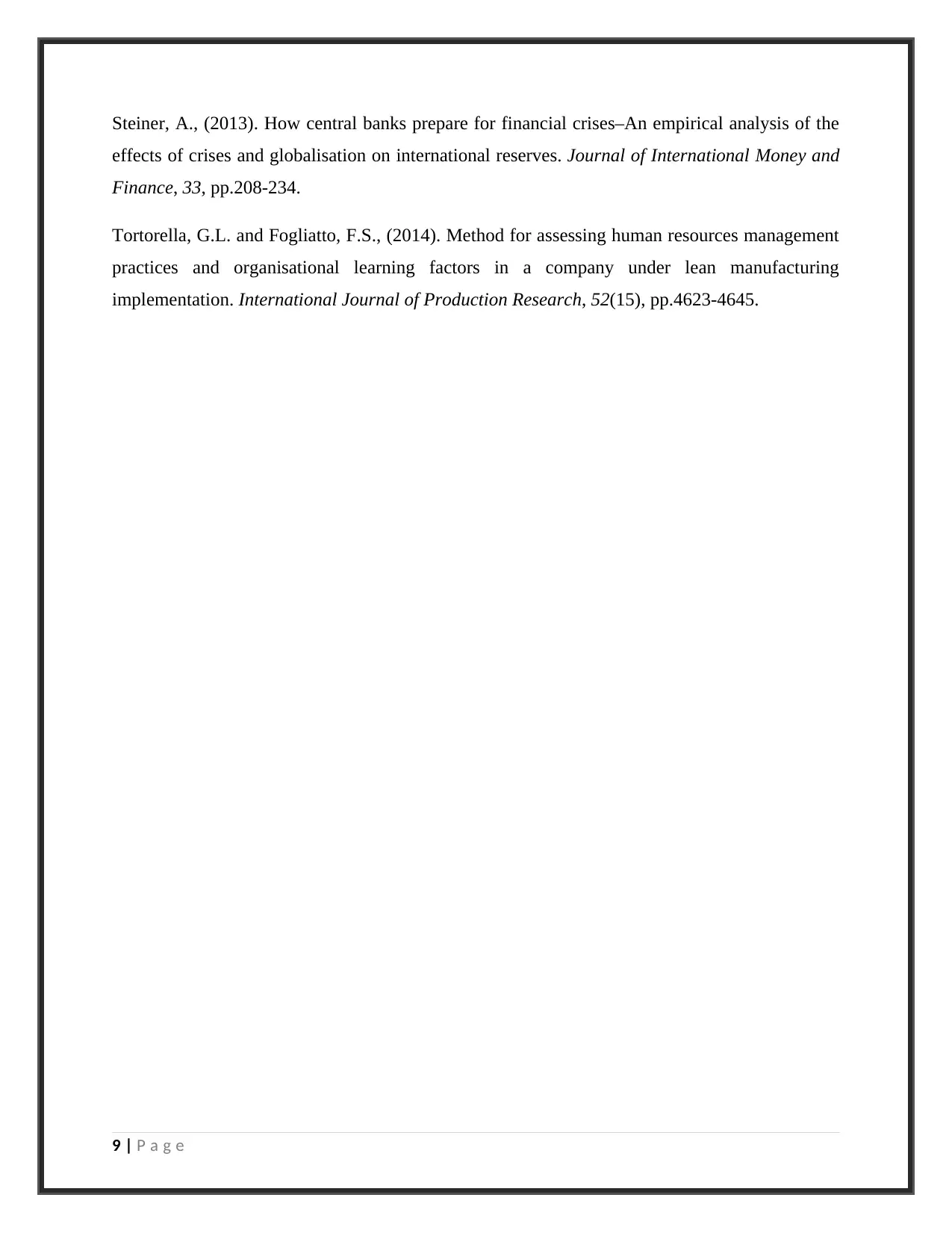
Steiner, A., (2013). How central banks prepare for financial crises–An empirical analysis of the
effects of crises and globalisation on international reserves. Journal of International Money and
Finance, 33, pp.208-234.
Tortorella, G.L. and Fogliatto, F.S., (2014). Method for assessing human resources management
practices and organisational learning factors in a company under lean manufacturing
implementation. International Journal of Production Research, 52(15), pp.4623-4645.
9 | P a g e
effects of crises and globalisation on international reserves. Journal of International Money and
Finance, 33, pp.208-234.
Tortorella, G.L. and Fogliatto, F.S., (2014). Method for assessing human resources management
practices and organisational learning factors in a company under lean manufacturing
implementation. International Journal of Production Research, 52(15), pp.4623-4645.
9 | P a g e
1 out of 10
Related Documents
Your All-in-One AI-Powered Toolkit for Academic Success.
+13062052269
info@desklib.com
Available 24*7 on WhatsApp / Email
![[object Object]](/_next/static/media/star-bottom.7253800d.svg)
Unlock your academic potential
Copyright © 2020–2025 A2Z Services. All Rights Reserved. Developed and managed by ZUCOL.





